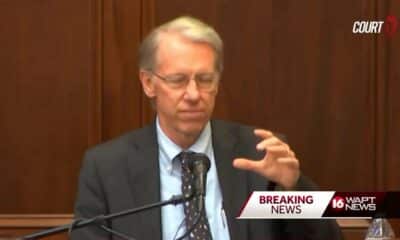Mississippi Today
Curtis Wilkie: President Biden should step aside to protect his country and his legacy
Curtis Wilkie is a retired journalist, author and professor who covered eight U.S. presidential campaigns and subsequent White House administrations during his storied reporting career.
President Biden should never have sought a second term.
I have an unusual perspective on this discussion dominating American politics considering I’ve known Joe Biden longer than any reporter who ever covered him. I’ve witnessed over the years how the relentless demands of the presidency have ravaged other occupants of the White House. And I share with Biden the frailties of old age that grip us both and have begun to diminish our physical and cognitive powers.
This is not a new concern of mine, produced by the president’s poor performance at last month’s debate. I reached this conclusion during a long conversation in March 2023 with two old friends who had closer political connections to Biden than my own. I felt his age and halting public appearances would make him vulnerable in 2024, increasing the possibility of Donald Trump’s return.
My friends sadly agreed. The man we remembered for his wit, admirable empathy and high energy was slipping.
My experience with Biden began in the summer of 1971 in Wilmington, Delaware. He was an ambitious 28-year-old New Castle County councilman; I was two years older, a new reporter for the local News-Journal papers. I enjoyed getting to know him. He was smart, with a touch of the smartass, brash with a fondness for F-bombs, and a cut above the average county councilman. We had both been inspired by John F. Kennedy’s promise in his inaugural address to “pass the torch” from the benign leadership of elderly leaders “to a new generation.” Implicit in Kennedy’s message was a call for activism. Biden chose politics, I chose journalism.
The next year Biden ran for a U.S. Senate seat held by an older, popular Republican incumbent. Biden’s campaign was widely thought folly, but he proved to be intellectually quick, an attractive young candidate. He won in a year Richard Nixon crushed his Democratic opposition across the country. Biden was not yet old enough to serve in the Senate; that would happen on his 30th birthday later in the month.
I was assigned to write a long piece on Biden’s political progress. I imagined it as “Young Mr. Biden Goes To Washington.” I spent a lot of time with him. He talked of his dreams. I don’t remember if he spoke about the White House but I feel confident that was his goal. One day I accompanied him on the Amtrak train to Washington. The journey took 75 minutes each way. (It would become a daily ritual for him for 36 years.) On Capitol Hill, he excitedly inspected his new home in a Senate office building and was careful to introduce himself to everyone he encountered. Otherwise, he said, “they’re going to think I’m an elevator operator,” a pet patronage job for young men on Capitol Hill.
I spoke with his wife Nelia over lunch at Wilmington’s finest restaurant, the Hotel Du Pont’s Brandywine Room, where precious works of art by Andrew Wyeth were on permanent display. I found Nelia as glamorous as the setting. She worried that life in the fast lane might disrupt their happy family — two young sons and a new daughter — and she dazzled me by volunteering that William Faulkner had been the subject of her college thesis. I began to think of the Bidens as the perfect all-American couple with an enviable future.
All of that was shattered a few days later. While Joe visited Washington again, Nelia took their children shopping for a Christmas tree and never got home. A collision involving the Bidens’ station wagon killed Nelia and their little girl and seriously injured both preschool sons. It had the impact of a death in the family for the entire state of Delaware.
Biden was prepared to give up his hard-earned seat before he ever occupied it, but a delegation of Democratic senators assured him they would provide special assistance if he would come to Washington. In a poignant public appearance in the hospital room with his sons, Biden announced that he would try to serve in the Senate but would resign if it didn’t work. He planned to come home to Wilmington on the Amtrak every night. “Delaware can always get another senator,” he said, “but my boys can’t get another father.”
Biden’s story had become so convulsed I never wrote the profile.
Four years later I wound up in Washington myself, covering the White House for the Boston Globe. Though we were working in the same city again I saw little of Biden. Congress was not part of my beat and Biden, who didn’t drink, went back to his sons rather than socialize in the nation’s capital at night. Despite his schedule, he developed a reputation as a rising star, laying the groundwork for eventual chairmanships for two of the most prestigious committees, Judiciary and Foreign Relations.
Along the way he also became known for his hair-trigger tongue that delivered impolitic statements and inappropriate off-the-cuff comments punctuated with blue language. He still seemed smart, but not always so wise.
Shortly after he announced in 1987 that he would run for his party’s next presidential nomination, I heard from my son, a student at Boston College. He wanted to drop out of school to work in the Biden campaign. He could do so with my blessing, I said, but warned him, “Joe’s going to implode.”
The implosion took place within weeks. In his speeches he regularly cited the words of Neil Kinnock, the British Labor Party leader, describing the valor of the working class in English coal country. One night in Iowa, Biden appropriated the story for himself. It fit his own background, growing up amid coal mining hardships in Scranton, Pennsylvania. Reporters traveling with the candidate ignored Biden’s curious remarks. They considered it unnewsworthy because he had previously been crediting Kinnock. When Maureen Dowd of the New York Times, who had not been there, magnified the event days later (with the help of the staff of Michael Dukakis’ rival campaign) with a front page account of Biden’s deception, it led to new accusations of plagiarism and exaggeration. Biden dropped out of the presidential race but vowed to be back.
His skills as a politician kept his name among credible contenders for president for another 20 years. I left Washington and my sightings of Biden were largely limited to television. At the 2000 Democratic convention, I was wandering on the floor when I heard someone shouting at me. It was Biden, who wanted to tell me that he had been to the “best (expletive) party of my life” at my alma mater, in the Grove at Ole Miss. It was a glimpse of the old Joe Biden I had known in Wilmington, charming and funny.
I’ve always felt that one’s eyes can be a measure of intelligence. When they’re bright, they usually reflect active interest; when they’re dull, there’s less in the brain behind them. The last conversation I had with Biden took place in Oxford in 2007. He spoke at Square Books to promote an autobiography. To establish affinity with his audience, he mentioned that his late wife had admired Faulkner. Afterward, we talked and I recalled my own interview with Nelia 35 years earlier when she told of her fondness for the novelist. Biden’s eyes glistened with tears.
So it’s been 17 years since I’ve seen him. I never had the opportunity to address him as “Mr. President.” He will always be Joe to me. This fall I’ll be 84 and Biden will be 82. I began worrying about both of us a couple of years ago. There began to be incidents in which I failed to be able to come up with the name of someone I know well. Or a simple word will go into hiding, popping up hours later. When I go blank in a conversation I apologize, laugh and blame it on my aging brain. I’m assured it’s nothing, but I find it troubling.
I began to notice Biden had some of the same handicaps. He butchers names or can’t remember them at all. Sometimes he appears balmy. His enthusiasm seems withered.
When Biden walked onto the set of the infamous debate last month, he did so with shuffling half-steps, the gait of an old man. Meanwhile, I’m afflicted with sciatica, and its constant pain has made me lame. I’ve not been able to walk for a year and use a rolling walker to move about.
I try to be philosophical. We have been fortunate to have lived this long, but we are paying for our longevity. Most of the decisions that confront me in retirement are inconsequential. But a president faces crises every day.
As a reporter I saw relatively young men whose campaigns I covered age dramatically. Jimmy Carter was 52 when he took office; he looked haggard when he left four years later. Bill Clinton’s hair turned gray almost overnight. George W. Bush entered the White House at age 44 and departed visibly older and exhausted.
It’s become painful to watch Biden on TV trying to demonstrate that he’s still capable of weathering the pressure. During his long career, he made some hard, proper decisions that affected his future. He emerged from the tragedy of the deaths of his wife and daughter by accepting the challenge of serving in the Senate, and he bowed out of the presidential races of 1988, 2008 and 2016 gracefully and kept his honor intact for 2020. That wisdom is no longer evident.
I wish that Biden had lived up to his promise in 2020 to be a “transitional president.” He had succeeded in driving Trump from the White House. His presidency has been mostly successful and free of catastrophe. Months ago Biden could have delivered a statesmanlike speech — prepared to serve out his four-year term and ready to leave the job to a younger generation. To walk away, genuinely able to say, “Mission Accomplished.”
Instead, his Democratic Party is faced with its worst nightmare, the distinct possibility of a sweeping victory in November for Trump and his MAGA followers. And instead of leaving a strong personal legacy, Biden may be remembered in the history of this turbulent period as a selfish man, weakened by age, who clung to his office too long.
A note from Mississippi Today Editor-in-Chief Adam Ganucheau: Curtis Wilkie is a Mississippi Today donor and trusted adviser to several of our journalists, myself included. We invited him to author this timely opinion piece, which does not necessarily reflect the views of the newsroom.
This article first appeared on Mississippi Today and is republished here under a Creative Commons license.
Mississippi Today
A Mississippi town moves a Confederate monument that became a shrouded eyesore
GRENADA (AP) — A Mississippi town has taken down a Confederate monument that stood on the courthouse square since 1910 — a figure that was tightly wrapped in tarps the past four years, symbolizing the community’s enduring division over how to commemorate the past.
Grenada’s first Black mayor in two decades seems determined to follow through on the city’s plans to relocate the monument to other public land. A concrete slab has already been poured behind a fire station about 3.5 miles (5.6 kilometers) from the square.
But a new fight might be developing. A Republican lawmaker from another part of Mississippi wrote to Grenada officials saying she believes the city is violating a state law that restricts the relocation of war memorials or monuments.
The Grenada City Council voted to move the monument in 2020, weeks after police killed George Floyd in Minneapolis. The vote seemed timely: Mississippi legislators had just retired the last state flag in the U.S. that prominently featured the Confederate battle emblem.
The tarps went up soon after the vote, shrouding the Confederate soldier and the pedestal he stood on. But even as people complained about the eyesore, the move was delayed by tight budgets, state bureaucracy or political foot-dragging. Explanations vary, depending on who’s asked.
A new mayor and city council took office in May, prepared to take action. On Sept. 11, with little advance notice, police blocked traffic and a work crew disassembled and removed the 20-foot (6.1-meter) stone structure.
“I’m glad to see it move to a different location,” said Robin Whitfield, an artist with a studio just off Grenada’s historic square. “This represents that something has changed.”
Still, Whitfield, who is white, said she wishes Grenada leaders had invited the community to engage in dialogue about the symbol, to bridge the gap between those who think moving it is erasing history and those who see it as a daily reminder of white supremacy. She was among the few people watching as a crane lifted parts of the monument onto a flatbed truck.
“No one ever talked about it, other than yelling on Facebook,” Whitfield said.
Mayor Charles Latham said the monument has been “quite a divisive figure” in the town of 12,300, where about 57% of residents are Black and 40% are white.
“I understand people had family and stuff to fight and die in that war, and they should be proud of their family,” Latham said. “But you’ve got to understand that there were those who were oppressed by this, by the Confederate flag on there. There’s been a lot of hate and violence perpetrated against people of color, under the color of that flag.”
The city received permission from the Mississippi Department of Archives and History to move the Confederate monument, as required. But Rep. Stacey Hobgood-Wilkes of Picayune said the fire station site is inappropriate.
“We are prepared to pursue such avenues that may be necessary to ensure that the statue is relocated to a more suitable and appropriate location,” she wrote, suggesting a Confederate cemetery closer to the courthouse square as an alternative. She said the Ladies Cemetery Association is willing to deed a parcel to the city to make it happen.
The Confederate monument in Grenada is one of hundreds in the South, most of which were dedicated during the early 20th century when groups such as the United Daughters of the Confederacy sought to shape the historical narrative by valorizing the Lost Cause mythology of the Civil War.
The monuments, many of them outside courthouses, came under fresh scrutiny after an avowed white supremacist who had posed with Confederate flags in photos posted online killed nine Black people inside the historic Emanuel African Methodist Episcopal Church in Charleston, South Carolina, in 2015.
Grenada’s monument includes images of Confederate president Jefferson Davis and a Confederate battle flag. It was engraved with praise for “the noble men who marched neath the flag of the Stars and Bars” and “the noble women of the South,” who “gave their loved ones to our country to conquer or to die for truth and right.”
A half-century after it was dedicated, the monument’s symbolism figured in a voting rights march. When the Rev. Martin Luther King Jr. and other civil rights leaders held a mass rally in downtown Grenada in June 1966, Robert Green of the Southern Christian Leadership Conference scrambled up the pedestal and planted a U.S. flag above the image of Davis.
The cemetery is a spot Latham himself had previously advocated as a new site for the monument, but he said it’s too late to change now, after the city already budgeted $60,000 for the move.
“So, who’s going to pay the city back for the $30,000 we’ve already expended to relocate this?” he said. “You should’ve showed up a year and a half ago, two years ago, before the city gets to this point.”
A few other Confederate monuments in Mississippi have been relocated. In July 2020, a Confederate soldier statue was moved from a prominent spot at the University of Mississippi to a Civil War cemetery in a secluded part of the Oxford campus. In May 2021, a Confederate monument featuring three soldiers was moved from outside the Lowndes County Courthouse in Columbus to another cemetery with Confederate soldiers.
Lori Chavis, a Grenada City Council member, said that since the monument was covered by tarps, “it’s caused nothing but more divide in our city.”
She said she supports relocating the monument but worries about a lawsuit. She acknowledged that people probably didn’t know until recently exactly where it would reappear.
“It’s tucked back in the woods, and it’s not visible from even pulling behind the fire station,” Chavis said. “And I think that’s what got some of the citizens upset.”
This article first appeared on Mississippi Today and is republished here under a Creative Commons license.
Crooked Letter Sports Podcast
Podcast: New Orleans sports columnist and author Jeff Duncan joins the podcast to talk about his new Steve Gleason book and the new-look New Orleans Saints.
Jeff Duncan went from the Mississippi Book Festival in Jackson on Saturday to Jerry World in Dallas on Sunday where he watched and wrote about the Saints’ total dismantling of the Dallas Cowboys. We talk about both events and also about what happened in high school and college football last weekend and what’s coming up this weekend.
Stream all episodes here.
This article first appeared on Mississippi Today and is republished here under a Creative Commons license.
Mississippi Today
On this day in 1899
Sept. 18, 1899

Scott Joplin, known as “the King of Ragtime,” copyrighted the “Maple Leaf Rag,” which became the first song to sell more than 1 million copies of sheet music. The popularity launched a sensation surrounding ragtime, which has been called America’s “first classical music.”
Born near Texarkana, Texas, Joplin grew up in a musical family. He worked on the railroad with other family members until he was able to earn money as a musician, traveling across the South. He wound up playing at the World’s Fair in Chicago in 1893, where he met fellow musician Otis Saunders, who encouraged him to write down the songs he had been making up to entertain audiences. In all, Joplin wrote dozens of ragtime songs.
After some success, he moved to New York City, hoping he could make a living while stretching the boundaries of music. He wrote a ragtime ballet and two operas, but success in these new forms eluded him. He was buried in a pauper’s grave in New York City in 1917.
More than six decades later, his music was rediscovered, initially by Joshua Rifkin, who recorded Joplin’s songs on a record, and then Gunther Schuller of the New England Conservatory, who performed four of the ragtime songs in concert: “My faculty, many of whom had never even heard of Joplin, were saying things like, ‘My gosh, he writes melodies like Schubert!’”
Joplin’s music won over even more admirers through the 1973 movie, “The Sting,” which won an Oscar for the music. His song, “The Entertainer,” reached No. 3 on Billboard and was ranked No. 10 among “Songs of the Century” list by the Recording Industry Association of America. His opera “Treemonisha” was produced to wide acclaim, and he won a Pulitzer Prize in 1976 for his special contribution to American music.
“The ragtime craze, the faddish thing, will obviously die down, but Joplin will have his position secure in American music history,” Rifkin said. “He is a treasurable composer.”
This article first appeared on Mississippi Today and is republished here under a Creative Commons license.
-
Mississippi News Video5 days ago
Woman arrested after reposting school threat in Calhoun County
-
News from the South - Louisiana News Feed5 days ago
Food drive underway for Hurricane Francine victims in Kenner
-
Mississippi Today2 days ago
On this day in 1925
-
News from the South - Kentucky News Feed4 days ago
The search for Joseph Couch intensifies
-
News from the South - Alabama News Feed2 days ago
Diddy Arrested In Manhattan | September 16, 2024 | News 19 at 10 p.m.
-
News from the South - Alabama News Feed5 days ago
Sylacauga Church welcomes Haitian migrants amid speculations
-
Mississippi Today3 days ago
Another Midwest drought is causing transportation headaches on the Mississippi River
-
News from the South - Florida News Feed6 days ago
Tropics update: Tropical Depression 7, 2 other disturbances brewing in Atlantic







































